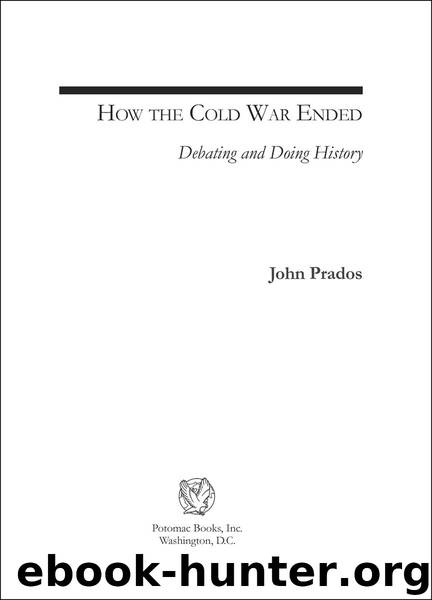How the Cold War Ended: Debating and Doing History (Issues in the History of American Foreign Relations) by John Prados

Author:John Prados [Prados, John]
Language: eng
Format: mobi
Publisher: Potomac Books
Published: 2010-12-31T05:00:00+00:00
Data Collection and Historical Narrative
Economic history is a well-established subfield of history, and social history the most exciting development in the field over the past two decades or so. Probably not too much needs to be said in regard to these two areas. A few points on data collection will be made below. But the more interesting theme to take up here is the idea of synergism. With more details and figures, the end of the Soviet Union could be told as a purely economic story. Similarly, it could be told as the cultural story of the failed nationalities policy. Either could be retailed as a unique explanation for the Soviet downfall, although both would require a dollop of political history, since Gorbachev’s perestroika was an avowed attempt to solve one of these problems, and as a reform effort, it had obvious implications for the second. But there are also clear interrelationships between the different factors. Nuclear plants were in Ukraine, poisonous chemical factories in Latvia. Conversely, a concentration of Soviet industrial investment in the Russian republic stunted growth in the other national states. And Soviet politics cut across all the economic and cultural divides, most notably in that glasnost constituted a national initiative not limited to any of the parts of the USSR. The different tracks here have a synergism in explaining the Soviet collapse, a value greater than the weight of the parts, as they also do in explaining how the Cold War ended. Historical inquiry has increasingly become a search for multi-causal explanations, and the observer should be alert to synergisms. There are times when “causes” evolve independently and culminate in an event, but there are also cases where the different tracks intersect and influence each other along the way to the nexus. The end of the Cold War is such a case. It cannot be reasonably explained without including the Soviet collapse, and the latter is itself a multi-causal sequence of events.
As a matter of constructing a historical narrative, there is another point to touch. The historian as writer is obligated to tell a story, not simply to relate facts or items of detail construed as facts or determined by diligent analysis to be facts. This is important not only from the standpoint of creating a successful work but also in order to communicate historical judgment, and even the facts themselves. The object of the exercise is to educate the reader on a subject the historian considers important. For that it is necessary to gain and hold the reader’s interest. A reader immersed in the story will come away with much more—both judgments and facts—than one who must struggle through the material. Creativity in telling the story requires the historian to make a different set of judgments: choices on what themes to press, what to include or exclude, at what length, in what depth. Those choices should be related to the historian’s analysis of the causes and sequence of events. Doing this actually simplifies the writing since the author thus provides her/himself with benchmarks that show the way forward.
Download
This site does not store any files on its server. We only index and link to content provided by other sites. Please contact the content providers to delete copyright contents if any and email us, we'll remove relevant links or contents immediately.
| Anthropology | Archaeology |
| Philosophy | Politics & Government |
| Social Sciences | Sociology |
| Women's Studies |
The Secret History by Donna Tartt(18187)
The Social Justice Warrior Handbook by Lisa De Pasquale(11957)
Thirteen Reasons Why by Jay Asher(8461)
This Is How You Lose Her by Junot Diaz(6451)
Weapons of Math Destruction by Cathy O'Neil(5841)
Zero to One by Peter Thiel(5498)
Beartown by Fredrik Backman(5369)
The Myth of the Strong Leader by Archie Brown(5243)
The Fire Next Time by James Baldwin(5024)
How Democracies Die by Steven Levitsky & Daniel Ziblatt(4966)
Promise Me, Dad by Joe Biden(4911)
Stone's Rules by Roger Stone(4866)
100 Deadly Skills by Clint Emerson(4695)
A Higher Loyalty: Truth, Lies, and Leadership by James Comey(4555)
Rise and Kill First by Ronen Bergman(4548)
Secrecy World by Jake Bernstein(4393)
The David Icke Guide to the Global Conspiracy (and how to end it) by David Icke(4386)
The Farm by Tom Rob Smith(4329)
The Doomsday Machine by Daniel Ellsberg(4250)
